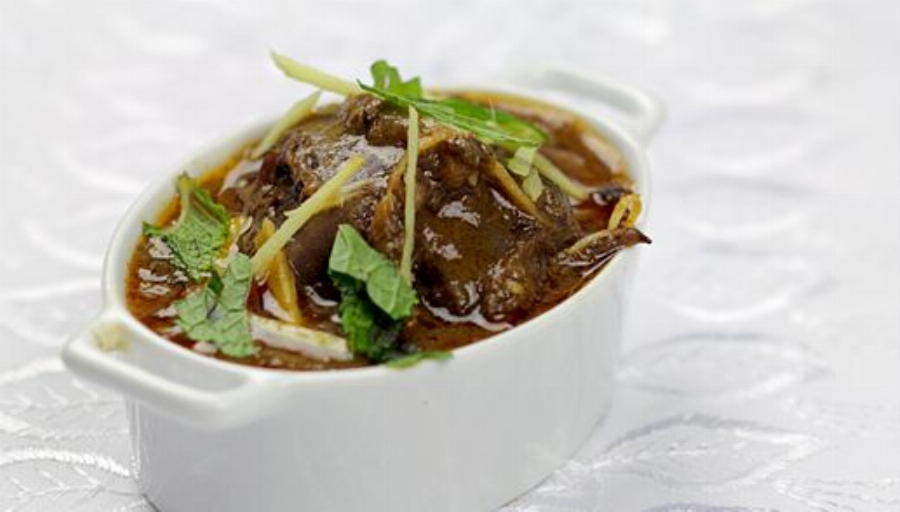There is a meat stew dish in every culture. The version from Indian cuisine, called nihari, is one of my favorites. I made some over the weekend with lamb shanks and lamb sirloin (my favorite), but other red meats such as mutton, goat or beef can work well. The key is to use very tender meat parts. The traditional garnish is a mix of fried onions, fresh ginger, cilantro, mint, cilantro, green chiles, sliced lemons and white radish sticks. I served it with naans which is also the standard way to enjoy the dish.
Nihari, in Urdu, is derived from the word ”nihar”, which translates to ”morning sunrinse”. Originally, the stew was usually eaten in the morning after prayers. The spicy stew is very flavorful thanks to the use of bone marrow. Interestingly, this is what gives Vietnamese phở broth its body.
My husband’s aunt, Phoopi, taught me how to make it, but I first heard of the dish when I met Abbi, Lulu’s late grandfather. He was a savvy bridge player and we would play from time to time. He told me that back in the days in Hyderabad, India, he would invite his pals over for an all night bridge game. There would always be a large pot of nihari waiting for them the following morning at the end of their game. The nihari would simmer overnight, tenderizing the meat and thickening the gravy. Lulu’s late grandmother, Baji, would finish the dish with bhaghar, which is the final red oil layer of ghee (clarified butter) commonly used in a lot of Indian dishes. Delicious!
1. Info for Nihari Recipe (Indian Lamb Stew)
- Cook Time: unavailable
- Total Time: unavailable
- Servings: 10
- Calories: unavailable
2. Ingredients for Nihari Recipe (Indian Lamb Stew)
- 2 pounds lamb sirloin and lamb shanks, boneless and bone-in meat
- 1 pound marrow bones (see tips)
- 1-½ cups canola oil
- 3 yellow onions, finely sliced
- 1 (2-inch) fresh ginger, peeled and crushed
- 1 tablespoon ginger garlic paste (see tips)
- 4 teaspoons kosher salt
- 1 tablespoon red chili powder, to taste
- ½ teaspoon garam masala
- 1 (2.11-ounce) package nihari curry seasoning (see tips)
- ¼ cup plain whole yogurt
- 5 tablespoons ghee (clarified butter), as needed
- ¼ cup whole wheat flour (or regular all-purpose flour), to taste
- 1 jalapeño green pepper (optional), thinly sliced
- 3 tablespoons cilantro, finely chopped
- 1 tablespoon fresh mint leaves
3. Directions:
- Cut the meat into 2-inch cubes. Pat the meat dry using paper towels.
- Reserve about 3 tablespoons of sliced onions.
- In a large pot, heat the oil. Add the ginger garlic paste, 2 teaspoons red chili powder and fresh ginger. As soon as it’s golden and fragrant, add the nihari seasoning and the remaining onions. Once the onions are fragrant, pan-sear each side of the lamb sirloin chunks for about 1-½ minutes (a total of about 9 minutes) until nicely browned. Add yogurt. Stir well and cook for about 5 minutes. Add about 1 quart of boiling water (see tips). Add the bones. Complete with more boiling water (count about a total scant 3 quarts of liquid). The water should barely cover the meat and bones. Bring to a full boil then lower the heat to a simmer. Cover with a lid to enable the steam to fall back in the pot. Let simmer for at least 4-5 hours (up to 6 hours), stirring often. Season with salt. Check for tenderness of the meat.
- In a bowl, combine the flour with ½ cup of water. Stir well. Add the mixture to the gravy. Bring to a boil and stir constantly until thickened. You could add more flour if you like a thicker consistency. Let simmer for 5-10 minutes. Adjust seasoning.
- This last step is called bhaghar: When you’re ready to serve, heat 1 tablespoon of canola oil in a small saucepan (I use a small 0.3-quart saucepan that I use exclusively for bhaghar). Once the oil is hot, melt the ghee over medium-low. You don’t want the ghee to burn. Add the rest of the red chili powder and reserved onions and let cook until golden. Immediately transfer the hot oil and onions to the pot of nihari. Cover the pot with the lid. Let the flavors infuse for 10 minutes.
- Garnish with mint, cilantro and fresh ginger cut into thin matchsticks.
- Serve warm with naans (Indian flat bread), along with white radish cut into long sticks and lemon wedges on the side.
- Bon appétit!
- Note: Resist the urge of discarding the layer of fat. It seems like a lot of oil and ghee but this layer of fat will ensure that the meat does not darken as the nihari cools down. Oh and the stew tastes even better the following day!

